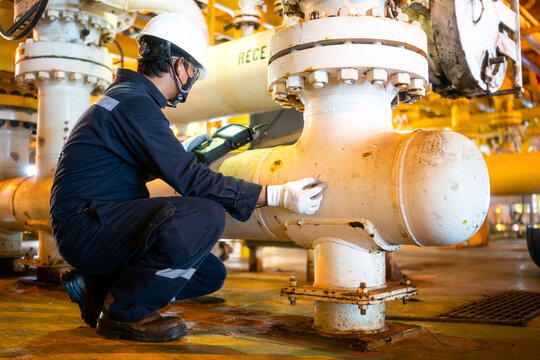Radiographic testing, or industrial radiography, is a non-destructive testing (NDT) technique commonly used to inspect materials such as metal and welds for defects.
The technique involves using X-rays or gamma rays to penetrate the material under inspection without harming it (non destructive). Depending on its thickness and density, the material absorbs the rays to varying degrees. The radiation is then captured on a piece of film or digital detector, producing an image of the material & internal structure.
Our team of highly experienced certified professionals offers quality computed and conventional industrial radiography in Grande Prairie and the Peace Region. We use the latest technology, such as the Carestream HPX-Pro for computed radiography, to ensure you get the information you need.
Our CGSB/SNT NDT level 3 professional has 15 years of experience in the NDT industry and practises precision and attention to detail on every job. Through ongoing training, our team stays current on all the latest codes and industry requirements, ensuring a high inspection quality standard.
Call us today, and we can ensure that the components in your project meet industry standards and regulatory requirements.

What are the Uses of Radiographic Non-Destructive Testing?
Radiographic testing can detect various types of defects in metal components and welds, including:
- Porosity
- Non-metallic inclusions
- Incomplete fusion
- Incomplete penetration
- Cracks
These flaws can weaken the structure of the component, leading to potential failures or leaks, which can
have serious safety, environmental, and financial consequences.
How is Radiographic Non-Destructive Testing Used?
Radiographic testing is commonly used for the inspection of:
- Pipelines
- Pressure piping
- Pressure vessels
- Tanks
- Other critical components
What is Computed Radiography?
Computed Radiography (CR) is an imaging technology that creates digital images from phosphor imaging plates rather than conventional film. The radiation passed through the piece under inspection is captured on a phosphor imaging plate on the opposite side. The plate is then processed using a laser scanner that reads the stored X-ray information and converts it into a digital image. Computed radiography requires specialized training, like our NDT level 3 professional has, to use the equipment and interpret the digital images.
What are the Benefits of Computed Radiography?
Computed radiography used for non-destructive testing has several benefits, including:
1. Digital Images:
One of the significant advantages of computed radiography is that it produces high-quality digital images that can be stored and shared electronically. Digital images can be manipulated for better visualization and interpretation and are easily transferred and archived.
2. Experienced Inspection:
Our full-time Level III auditor inspects all of the images, ensuring you get an accurate interpretation EVERY TIME. Every fab shop or pipeline company has dealt with it: you call an NDT company and get one of their less experienced technicians. He calls a repair, leaves, and when the welder goes in to fix it, they don’t find anything because the call was wrong. We are the only NDT company in town that can guarantee a level 3 audit from an industry professional on every single repair called, ensuring we get it right every time.
3. Space & Cost Savings:
computed radiography eliminates the need for film processing, storage space, and disposal costs. VagaboNDE is one of the only companies offering computed radiography based out of Grande Prairie, servicing the Peace Region and beyond, creating large cost savings on travel when your needs are in northwestern Alberta and northeastern BC.
4. Easy Management:
The ability to produce high-quality digital images that can be manipulated using computer software. Making it easier to manage and navigate a folder of weld image files instead of sorting through boxes upon boxes of x-ray film.
5. Accessibility:
Our Technology
Our team uses the best technology available, the Carestream HPX-PRO. The HPX-PRO Portable Digital System is designed for high throughput digital imaging in rugged NDT environments. Lightweight and portable, it produces high-quality digital images for analysis and final reporting.
What is Conventional Radiography?
Conventional radiography, also known as film-based radiography, is an imaging technology that uses X-rays or gamma rays to create images on film. This method has been used for over a century and is still widely used.
In conventional radiography, a radioactive isotope emits a beam of gamma rays passing through the object onto a film. The piece under inspection (a pipeline weld for example) will absorb different amounts of radiation based on material density, creating a latent image on the film that shows the varying levels of radiation absorption. This film is then processed using multiple chemical baths to produce a visible image that our certified professionals can interpret.
What are the Benefits of Conventional Radiography?
The benefits of conventional radiography include:
1. Accessibility:
Conventional radiography has a longer history in the oil and gas industry, with many companies offering this service, making it familiar, easily accessible, and readily accepted in every quality manual. We’re happy to provide conventional radiography to all our clients.
2. Cost savings:
Conventional radiography does not require expensive imaging plates and can therefore be offered for less than computed radiography.
It is important to note that conventional radiography requires large amounts of film, which can be cumbersome and require specialized storage facilities.